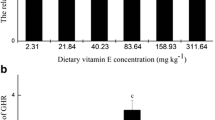Abstract
The selenium (Se)-containing imidazole compound selenoneine (2-selenyl-Nα, Nα, Nα-trimethyl-l-histidine) is a strong scavenger of reactive oxygen species (ROS) in the blood and tissues of fish. Intravenous injection of selenoneine into yellowtail has been shown to delay changes in meat color and prevent met-myoglobin formation in red muscle. In this study, to determine whether selenoneine can improve stress tolerance and meat quality in fish, we examined the biological antioxidant functions of selenoneine in fish in vivo. Juvenile amberjack (Seriola dumerili) were cultured and fed a diet containing selenoneine for 9 weeks. Total Se and selenoneine concentrations increased in amberjack blood and muscles during the study period. We also measured the oxidative–redox potential (ORP) in fish muscle using an ORP electrode and found that muscle ORP and ROS levels were closely correlated with the Se concentration in blood and muscles. We conclude that dietary administration of selenoneine led to its accumulation in amberjack blood and muscles, resulting in reduced ORP and ROS levels in the muscles.




Similar content being viewed by others
References
Bell JG, Cowey CB, Youngson A (1984) Rainbow trout liver microsomal lipid peroxidation: the effect of purified glutathione peroxidase, glutathione S-transferase and other factors. Biochem Biophys Acta 795:91–99
Brigelius-Flohé R (1999) Tissue-specific functions of individual glutathione peroxidases. Free Radical Biol Med 27:951–965
Burk RF, Hill KE (1994) Selenoprotein P: A selenium-rich extracellular glycoprotein. J Nutr 124:1891–1897
Combs GF, Combs SB (1986) The role of selenium in nutrition. Academic Press, New York
El-Bayoumy K (2001) The protective role of selenium on genetic damage and on cancer. Mutat Res 475:123–139
Gatlin DM, Wilson RP (1984) Dietary selenium requirement of fingerling channel catfish. J Nutr 114:627–633
Ghose A, Fleming J, Harrison PR (2001) Selenium and signal transduction: roads to cell death and anti-tumour activity. BioFactors 14:127–133
Hatfield DL, Berry MJ, Gladyshev VN (eds) (2006) Selenium: its molecular biology and role in human health, 2nd edn. Springer, New York
Himeno S, Imura N (2000) New aspects of physiological and pharmacological roles of selenium. J Health Sci 46:393–398
Hilton JW, Hodson PV, Slinger SJ (1980) The requirement and toxicity of selenium in rainbow trout (Salmo gairdneri). J Nutr 110:2527–2535
Kiremidjian-Schumacher L, Roy M (2001) Effect of selenium on the immunocompetence of patients with head and neck cancer and on adoptive immunotherapy of early and established lesions. BioFactors 14:161–168
Kryukov GV, Castellano S, Novoselov SV, Lobanov AV, Zehtab O, Guigó R, Gladyshev VN (2003) Characterization of mammalian selenoproteomes. Science 300:1439–1443
Kryukov GV, Gladyshev VN (2000) Selenium metabolism in zebrafish: multiplicity of selenoprotein genes and expression of a protein containing 17 selenocysteine residues. Genes Cells 5(12):1049–1060
Mustacich D, Powis G (2000) Thioredoxin reductase. Biochem J 346(Pt 1):1–8
Poston HA, Combs GF, Leibovitz L (1976) Vitamin E and selenium interrelations in the diet of Atlantic salmon (Salmo salar): gross, histological and biochemical deficiency signs. J Nutr 106:892–904
Rayman MP (2000) The importance of selenium to human health. Lancet 356:233–241
Rotruck JT, Pope AL, Ganther HE, Swanson AB, Hafeman DG, Hoekstra WG (1973) Selenium: biochemical role as a component of glutathione peroxidase. Science 179:588–590
Salonen JT, Alfthan G, Huttunen JK, Pikkarainen J, Puska P (1982) Association between cardiovascular death and myocardial infarction and serum selenium in matched-pair longitudinal study. Lancet 2:175–179
Yamashita Y, Omura Y, Okazaki E (2005) Total mercury and methylmercury levels in commercially important fishes in Japan. Fish Science 71:1029–1035
Yamashita Y, Yamashita M (2010) Identification of a novel selenium-containing compound, selenoneine, as the predominant chemical form of organic selenium in the blood of bluefin tuna. J Biol Chem 285:18134–18138
Yamashita Y, Yabu T, Yamashita M (2010) Discovery of the strong antioxidant selenoneine in tuna and selenium redox metabolism. World J Biol Chem 1:144–150
Yamashita Y, Amlund H, Suzuki T, Hara T, Hossain AM, Yabu T, Touhata K, Yamashita M (2011) Selenoneine, total selenium, and total mercury content in the muscle of fishes. Fish Science 77:679–686
Yamashita Y, Yabu T, Touhata K, Yamashita M (2012) Purification characterization of glutathione peroxidase 1 in the red muscle of Pacific bluefin tuna Thunnus orienalis. Fish Sci 78:407–413
Yamashita M, Yamashita Y, Suzuki T, Kani Y, Mizusawa N, Imamura S, Takemoto K, Hara T, Hossain A, Yabu T, Touhata K (2013) Selenoneine, a novel selenium-containing compound, mediates detoxification mechanisms against methylmercury accumulation and toxicity in zebrafish embryo. Mar Biotechnol 15:559–570
Author information
Authors and Affiliations
Corresponding author
Ethics declarations
Conflict of Interest
The authors declare no competing interests.
Additional information
Publisher's Note
Springer Nature remains neutral with regard to jurisdictional claims in published maps and institutional affiliations.
Rights and permissions
About this article
Cite this article
Tohfuku, T., Ando, H., Morishita, N. et al. Dietary Intake of Selenoneine Enhances Antioxidant Activity in the Muscles of the Amberjack Seriola dumerili Grown in Aquaculture. Mar Biotechnol 23, 847–853 (2021). https://doi.org/10.1007/s10126-021-10067-y
Received:
Accepted:
Published:
Issue Date:
DOI: https://doi.org/10.1007/s10126-021-10067-y




